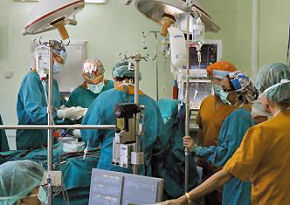28 November 2012
Reality check urged for double mastectomies
by Will Parker
 Around 70 percent of women who have both breasts removed following a breast cancer diagnosis do so despite a very low risk of cancer in the healthy breast, leading medicos to call for improved information for patients. According to Sarah Hawley, the author of a new report that details the increase in double mastectomies, the question of overtreatment among patients looms large.
Around 70 percent of women who have both breasts removed following a breast cancer diagnosis do so despite a very low risk of cancer in the healthy breast, leading medicos to call for improved information for patients. According to Sarah Hawley, the author of a new report that details the increase in double mastectomies, the question of overtreatment among patients looms large.
Hawley, from the University of Michigan Comprehensive Cancer Center, says she found that 90 percent of women who had surgery to remove both breasts reported being "very worried" about the cancer recurring. But, she stresses, a diagnosis of breast cancer in one breast does not increase the likelihood of breast cancer recurring in the other breast for most women.
"Women appear to be using worry over cancer recurrence to choose contralateral prophylactic mastectomy. This does not make sense, because having a non-affected breast removed will not reduce the risk of recurrence in the affected breast," Hawley explained.
For the study, Hawley and her co-researchers looked at 1,446 women who had been treated for breast cancer and who had not had a recurrence. They found that 7 percent of women had surgery to remove both breasts. Among women who had a mastectomy, nearly 1-in-5 had a double mastectomy.
"For women who do not have a strong family history or a genetic [BRCA1 or BRCA2] finding, we would argue it's probably not appropriate to get the unaffected breast removed," says Hawley. She notes that a double mastectomy is a bigger operation that is associated with more complications and a more difficult recovery. Additionally, women might still need to undergo chemotherapy or radiation therapy after their surgery - treatments that are known to reduce the risk of cancer recurring - which could delay their recovery further.
Concern about recurrence is one of the biggest factors driving the decision but Hawley says it's important to educate women that a contralateral mastectomy will not reduce the risk of recurrence. To that end, she her co-researchers are developing a decision tool to help guide women through breast cancer treatment choices.
"This procedure is still done and it's done in women who don't need to have it done. A decision tool like ours will solicit common misconceptions about breast cancer treatment and give women feedback to help them fully understand the options and risks involved," Hawley concluded.
Related:
Discuss this article in our forum
Early stage breast cancer sufferers choosing double mastectomies
Lack of sleep a new risk factor for aggressive breast cancer
Breast cancer gene plays role in heart disease
Source: University of Michigan Health System
